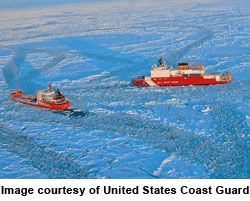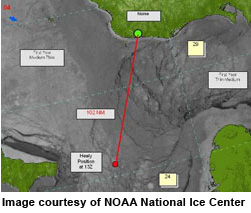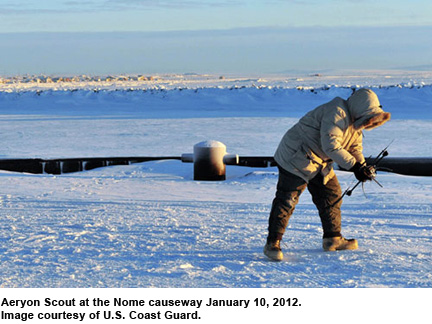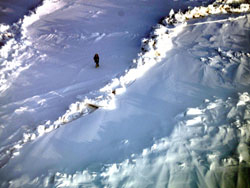Operating under an Emergency Certificate of Authorization (COA) from the Federal Aviation Association, University of Alaska Fairbanks Geophysical Institute researchers are using the Scout to prepare for the arrival of Russian tanker, Renda, carrying vital fuel supplies to the remote community of Nome Alaska.

As the community of Nome Alaska anxiously awaits critical fuel supplies, the Aeryon Scout is being used by researchers at the University of Alaska Fairbanks to assess safety and environmental impact in and around Nome’s harbor ahead of the arrival of the U.S. Coast Guard icebreaker Healy, and the fuel tanker Renda. Researchers are using aerial images and video from the Scout to determine daily ice conditions including the formation of pressure ridges, potentially dangerous obstacles formed when two ice surfaces push together. These images are being used by the research team on the ice, and are being sent to the ships as they advance towards Nome.

The nature of the mission, remote location, and harsh environmental conditions called for use of an Unmanned Aerial Vehicle (UAV) rather than manned aircraft. The fuel delivery mission is occurring as the region is experiencing extreme winter weather and many local communities have already received more snowfall than is typical for the entire winter. The Alaska coast has been slammed with a series of storms with high winds and temperatures below -20F. Use of the Scout removes the human element and allows researchers to perform their important task from a safe distance. Greg Walker, manager at the Geophysical Institute’s Poker Flat Research Range and his team are using two Aeryon Scouts on loan from BP Alaska, who also recently demonstrated use of the Scout for oil spill response in Alaska in July 2011. The University of Alaska Fairbanks responded to an urgent request from the Alaska Department of Environmental Conservation whose representatives had attended the oil spill demonstration and requested the Scout for use in the Nome operation.
“The Aeryon Scout is designed for exactly this type of role and environment —deploying quickly to provide an aerial perspective in any location and in any weather,” said Dave Kroetsch, President of Aeryon Labs. “The fact is the Scout operates reliably in wind and weather conditions when many other small UAVs simply cannot fly.”

Currently the U.S. Coast Guard icebreaker Healy and the Russian fuel tanker Renda are continuing their journey to Nome. However, when the Renda arrives it will have to enter the harbor to unload fuel without any assistance, as it is too shallow for the Healy. The Aeryon Scout is expected to stay on-station relaying images to coordinators on the ground and on the Renda. 

The Scout is currently operating in Nome under an emergency Unmanned Aircraft System (UAS) Certificate of Authorization (COA) granted to the University of Alaska Fairbanks by the Federal Aviation Administration (FAA)—one of only a handful of emergency COAs issued for civilian use. An emergency COA grants clearance for immediate use of UAS in conditions of distress or urgency when there is or has the extreme possibility of loss of life, safe manned flight is not possible, and whereby the UAS is already operating under an existing COA. The FAA is expected to publish updated UAS regulations imminently, broadening use of UAS over U.S. skies under its UAS initiative.

Weighing under 3 lbs., the Aeryon Scout micro-UAV is designed to be flown by anyone with only a few minutes of training, through simple point-and-click map-based navigation and automated flight safety features. From a small case or backpack, the Scout can be assembled in seconds without tools and operates in extreme weather and environments due to its sturdy construction, weather sealing, and unmatched flight performance.
Additional photos are available in our media gallery and the U.S. Coast Guard continues to provide updates and photos from the Healy on their Renda/Nome Fuel Delivery site.
About Aeryon Labs, Inc.
Aeryon Labs provides robotic solutions to real-world problems through the design and manufacture of best-in-class small unmanned aerial vehicles (UAVs) and related systems. Recently proven in several military trials, including the 2011 U.S. DoD Empire Challenge, the Scout allows police, military and civil users to easily collect real-time aerial intelligence, with a system small enough to fit in a backpack or car trunk. With expertise in robotics, control systems, and digital imaging, Aeryon Labs develops state-of-the-art products while remaining focused on end-user ease of use. For more information, visit: www.aeryon.com


